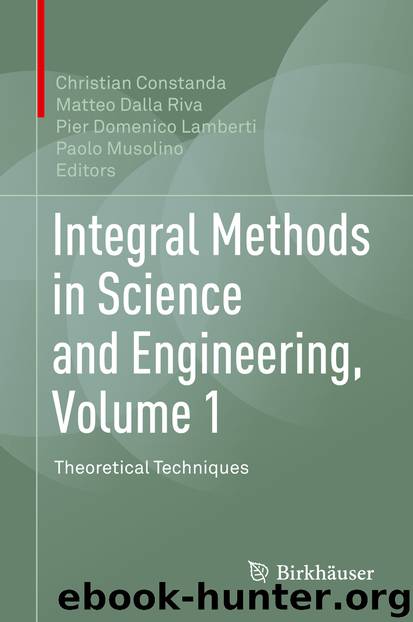Integral Methods in Science and Engineering, Volume 1 by Christian Constanda Matteo Dalla Riva Pier Domenico Lamberti & Paolo Musolino

Author:Christian Constanda, Matteo Dalla Riva, Pier Domenico Lamberti & Paolo Musolino
Language: eng
Format: epub
Publisher: Springer International Publishing, Cham
With the methods mentioned above, we calculate the relative error between the numerical phase for p = 1, 2, 3 and the exact phase for p = 1, 2, 3 for different degrees, wavenumbers κ = 2 and κ = 3, n = 4, and R = 1, see Figures 13.1 (A) and (B). One can see that the relative error is much larger by using constant interpolation than it is with less degree by using product Gaussian quadrature, Lebedev quadrature, or spherical t-design. Especially the Lebedev quadrature calculates highly accurate phases. We plot the numerical phases calculated with Lebedev quadrature (N = 86) against the wavenumbers κ ∈ [2, 6. 5], see Figure 13.2. Usually the inside-outside duality approach is used with constant interpolation and degree N = 120, which is slower in computational time than Lebedev quadrature with N = 86. The exact interior transmission eigenvalues in this interval are κ = 3. 141593, 3. 692445, 4. 261683, 4. 831855, 5. 399436, 5. 963690, 6. 283185, and 6. 373336. Using Lebedev quadrature with N = 86, we obtain the above calculated interior transmission eigenvalues accurate within the chosen grid size. We obtain the same results using near-field data (see also [LePe15a, p. 17]). As a remark, we would like to mention that if we use only the data of the upper half-sphere in the different approximations of the far-field operator, our resulting phases are not even close to the exact phases. Thus, it is not possible to calculate interior transmission eigenvalues with these limited data. Of course, we are also able to calculate interior Dirichlet eigenvalues. Using Lebedev with N = 84 yields 3. 14, 4. 49, 5. 23, and 5. 76 for the unit sphere and 2. 97, 4. 05, 4. 35, and 5. 16 for the prolate spheroid with parameters b = 6∕5 and a = 1, respectively. The results are accurate within the chosen grid size of 0.01 (compare with [Kl13, Table 11]). The results for the constant interpolation are not that accurate. For example, we obtain 5. 17 instead of 5. 16 for the prolate spheroid.
Fig. 13.1Relative error between the numerical phases and the exact phases with wavenumbers κ = 2 (plot A) and κ = 3 (plot B) for the transmission problem and for various quadratures using a sphere with radius R = 1 and index of refraction n = 4. The constant interpolation is characterized by diamonds, the product Gaussian quadrature by circles, the Lebedev quadrature by triangles, and the spherical t-design approximation by squares. The black markers denote the relative error for μ 1, the grey markers for μ 2, and the white ones for μ 3
Download
This site does not store any files on its server. We only index and link to content provided by other sites. Please contact the content providers to delete copyright contents if any and email us, we'll remove relevant links or contents immediately.
Modelling of Convective Heat and Mass Transfer in Rotating Flows by Igor V. Shevchuk(6217)
Weapons of Math Destruction by Cathy O'Neil(5813)
Factfulness: Ten Reasons We're Wrong About the World – and Why Things Are Better Than You Think by Hans Rosling(4478)
Descartes' Error by Antonio Damasio(3157)
A Mind For Numbers: How to Excel at Math and Science (Even If You Flunked Algebra) by Barbara Oakley(3100)
Factfulness_Ten Reasons We're Wrong About the World_and Why Things Are Better Than You Think by Hans Rosling(3041)
TCP IP by Todd Lammle(3006)
Applied Predictive Modeling by Max Kuhn & Kjell Johnson(2903)
Fooled by Randomness: The Hidden Role of Chance in Life and in the Markets by Nassim Nicholas Taleb(2851)
The Tyranny of Metrics by Jerry Z. Muller(2841)
The Book of Numbers by Peter Bentley(2776)
The Great Unknown by Marcus du Sautoy(2531)
Once Upon an Algorithm by Martin Erwig(2471)
Easy Algebra Step-by-Step by Sandra Luna McCune(2463)
Lady Luck by Kristen Ashley(2404)
Practical Guide To Principal Component Methods in R (Multivariate Analysis Book 2) by Alboukadel Kassambara(2377)
Police Exams Prep 2018-2019 by Kaplan Test Prep(2351)
All Things Reconsidered by Bill Thompson III(2256)
Linear Time-Invariant Systems, Behaviors and Modules by Ulrich Oberst & Martin Scheicher & Ingrid Scheicher(2228)
